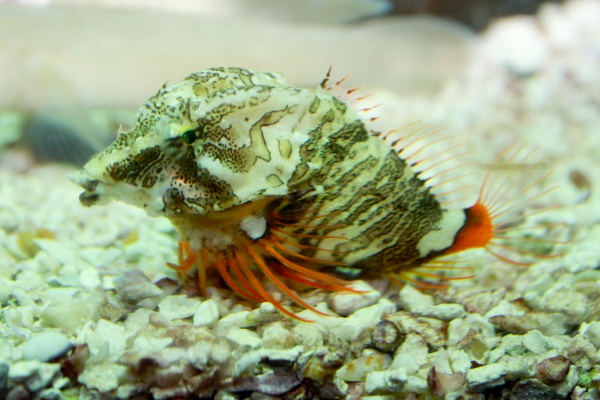Facts About Grunt sculpin
The grunt sculpin, also known as the grunt-fish, is a captivating little fish native to the eastern Pacific Ocean. First described by Albert Günther in 1874 and named in honor of naturalist John Richardson, this species is noted for the distinctive "grunting" sound it produces when handled. These fish are commonly found near the shore, often nestled inside empty giant barnacle shells.
One of the most endearing traits of the grunt sculpin is how it "hops" along the ocean floor using its orange fins. It has a short, robust body and a long, narrow mouth designed for consuming small prey. This fish belongs to the Actinopterygii class of ray-finned fishes and is part of the Scorpaeniformes order, commonly known as mail-cheeked fishes. It is the sole member of the Rhamphocottidae family within the superfamily Cottidae. The name "grunt sculpin" derives from "rhamp" meaning snout, and "cottus" meaning sculpin, a reference to its physical characteristics and John Richardson.
Grunt sculpins can grow up to 8.9 cm in length. They have a distinctive appearance with a large head, short body, elongated snout resembling that of a pig, and vibrant orange fins. Their coloration typically features a mix of yellow with brown stripes, accentuated by their bright orange pectoral fins. Their small mouths and elongated snouts make them well-suited for feeding on small crustaceans, although they occasionally consume small fish or worms.
These fish favor shallow waters near rocky shores, kelp forests, and sandy beaches but can be found at depths of up to 165 meters. They have a particular affinity for using empty giant barnacles as their homes.
Regarding reproduction, grunt sculpins have their mating season from August to October along rocky shores, with females taking an active role in the mating process. After laying approximately 150 eggs, the larvae hatch after about 16-20 weeks. These larvae are typically observed from March to June. For survival, the larvae need to remain near the shore, as venturing into the open ocean can be perilous. The precise impact of environmental factors on their behavior and adaptation to shore habitats remains somewhat enigmatic.

 Guyana
Guyana